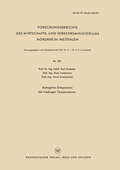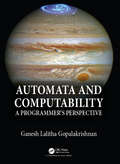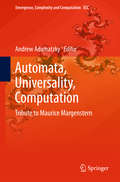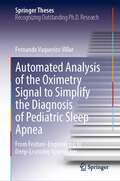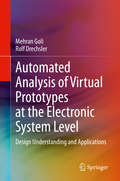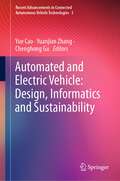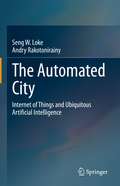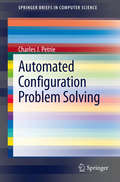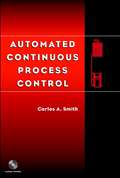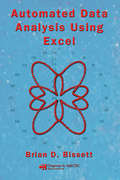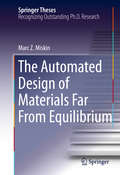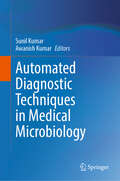- Table View
- List View
Autogenes Entspannen bei niedrigen Temperaturen (Forschungsberichte des Wirtschafts- und Verkehrsministeriums Nordrhein-Westfalen #531)
by Karl KrekelerAutolust! Dieselfrust?
by Klaus-Geert Heyne Gabriele SchmiedgenFür das vorliegende Sachbuch ist der „Diesel-Skandal“ der Auslöser zu informieren, über die Automobile von heute und morgen, über ihre Antriebe, die Elektromobilität, das Autonome Fahren, die Schadstoffe und den Klimaschutz. Die Aufregung vieler Menschen nehmen die beiden Autoren zum Anlass, mit manchen Meinungen, Ideologien, Vorurteilen und Zukunftsängsten aufzuräumen. In allgemein verständlicher, lockerer Form stellen sie die Hintergründe und Fakten des Autos und seiner Antriebe dar. Dieser Leitfaden kann unseren Mitmenschen, den Entscheidungsträgern und Meinungsmachern eine wertvolle Hilfe sein: Wie sieht die Autowelt im Jahre 2030 aus?
Automata and Complexity: Essays Presented to Eric Goles on the Occasion of His 70th Birthday (Emergence, Complexity and Computation #42)
by Andrew AdamatzkyThis book commemorates Eric Goles’s achievements in science and engineering. Eric Goles is one of the world leaders in the field of automata and complexity. His groundbreaking discoveries are in the theory and analysis of complex systems, particularly in the field of discrete systems dynamics such as neural networks, automata networks, majority networks, bootstrap percolation models, cellular automata, computational complexity theory, discrete mathematics, and theoretical computer science. Topics include cellular automata, complex networks, models of computation, expansive systems, sandpile automata, Penrose tilings, Boolean automata, models of infection, Fibonacci trees, dominos, reversible automata, and fungal automata. The chapters are authored by world leaders in computer science, physics, mathematics, and engineering. The book will be a pleasure to explore for readers from all walks of life, from undergraduate students to university professors, from mathematicians, computer scientists, and engineers to chemists and biologists.
Automata and Computability: A Programmer's Perspective
by Ganesh GopalakrishnanAutomata and Computability is a class-tested textbook which provides a comprehensive and accessible introduction to the theory of automata and computation. The author uses illustrations, engaging examples, and historical remarks to make the material interesting and relevant for students. It incorporates modern/handy ideas, such as derivative-based parsing and a Lambda reducer showing the universality of Lambda calculus. The book also shows how to sculpt automata by making the regular language conversion pipeline available through a simple command interface. A Jupyter notebook will accompany the book to feature code, YouTube videos, and other supplements to assist instructors and studentsFeatures Uses illustrations, engaging examples, and historical remarks to make the material accessible Incorporates modern/handy ideas, such as derivative-based parsing and a Lambda reducer showing the universality of Lambda calculus Shows how to "sculpt" automata by making the regular language conversion pipeline available through simple command interface Uses a mini functional programming (FP) notation consisting of lambdas, maps, filters, and set comprehension (supported in Python) to convey math through PL constructs that are succinct and resemble math Provides all concepts are encoded in a compact Functional Programming code that will tesselate with Latex markup and Jupyter widgets in a document that will accompany the books. Students can run code effortlessly href="https://github.com/ganeshutah/Jove.git/"here.
Automata and Computability: A Programmer's Perspective
by Ganesh GopalakrishnanAutomata and Computability is a class-tested textbook which provides a comprehensive and accessible introduction to the theory of automata and computation. The author uses illustrations, engaging examples, and historical remarks to make the material interesting and relevant for students. It incorporates modern/handy ideas, such as derivative-based parsing and a Lambda reducer showing the universality of Lambda calculus. The book also shows how to sculpt automata by making the regular language conversion pipeline available through a simple command interface. A Jupyter notebook will accompany the book to feature code, YouTube videos, and other supplements to assist instructors and studentsFeatures Uses illustrations, engaging examples, and historical remarks to make the material accessible Incorporates modern/handy ideas, such as derivative-based parsing and a Lambda reducer showing the universality of Lambda calculus Shows how to "sculpt" automata by making the regular language conversion pipeline available through simple command interface Uses a mini functional programming (FP) notation consisting of lambdas, maps, filters, and set comprehension (supported in Python) to convey math through PL constructs that are succinct and resemble math Provides all concepts are encoded in a compact Functional Programming code that will tesselate with Latex markup and Jupyter widgets in a document that will accompany the books. Students can run code effortlessly href="https://github.com/ganeshutah/Jove.git/"here.
Automata, Languages and Programming: 29th International Colloquium, ICALP 2002, Malaga, Spain, July 8-13, 2002. Proceedings (Lecture Notes in Computer Science #2380)
by Peter Widmayer Francisco Triguero Rafael Morales Matthew Hennessy Stephan Eidenbenz Ricardo ConejoAutomata, Universality, Computation: Tribute to Maurice Margenstern (Emergence, Complexity and Computation #12)
by Andrew AdamatzkyThis book is an intellectually stimulating excursion into mathematical machines and structures capable for a universal computation. World top experts in computer science and mathematics overview exciting and intriguing topics of logical theory of monoids, geometry of Gauss word, philosophy of mathematics in computer science, asynchronous and parallel P-systems, decidability in cellular automata, splicing systems, reversible Turing machines, information flows in two-way finite automata, prime generators in automaton arrays, Grossone and Turing machines, automaton models of atomic lattices. The book is full of visually attractive examples of mathematical machines, open problems and challenges for future research. Those interested in the advancement of a theory of computation, philosophy of mathematics, future and emergent computing paradigms, architectures and implementations will find the book vital for their research and development.
Automated Analysis of the Oximetry Signal to Simplify the Diagnosis of Pediatric Sleep Apnea: From Feature-Engineering to Deep-Learning Approaches (Springer Theses)
by Fernando Vaquerizo VillarThis book describes the application of novel signal processing algorithms to improve the diagnostic capability of the blood oxygen saturation signal (SpO2) from nocturnal oximetry in the simplification of pediatric obstructive sleep apnea (OSA) diagnosis. For this purpose, 3196 SpO2 recordings from three different databases were analyzed using feature-engineering and deep-learning methodologies. Particularly, three novel feature extraction algorithms (bispectrum, wavelet, and detrended fluctuation analysis), as well as a novel deep-learning architecture based on convolutional neural networks are proposed. The proposed feature-engineering and deep-learning models outperformed conventional features from the oximetry signal, as well as state-of-the-art approaches. On the one hand, this book shows that bispectrum, wavelet, and detrended fluctuation analysis can be used to characterize changes in the SpO2 signal caused by apneic events in pediatric subjects. On the other hand, it demonstrates that deep-learning algorithms can learn complex features from oximetry dynamics that allow to enhance the diagnostic capability of nocturnal oximetry in the context of childhood OSA. All in all, this book offers a comprehensive and timely guide to the use of signal processing and AI methods in the diagnosis of pediatric OSA, including novel methodological insights concerning the automated analysis of the oximetry signal. It also discusses some open questions for future research.
Automated Analysis of Virtual Prototypes at the Electronic System Level: Design Understanding and Applications
by Mehran Goli Rolf DrechslerThis book describes a set of SystemC‐based virtual prototype analysis methodologies, including design understanding, verification, security validation, and design space exploration. Readers will gain an overview of the latest research results in the field of Electronic Design Automation (EDA) at the Electronic System Level (ESL). The methodologies discussed enable readers to tackle easily key tasks and applications in the design process.
Automated and Autonomous Spatial Mobilities (Transport, Mobilities and Spatial Change)
by Aharon KellermanIn this ground-breaking book Aharon Kellerman explores a rapidly developing aspect of contemporary life: automated and autonomous spatial mobilities and their social and urban implications. Distinguishing between automation, or self-doing, and autonomy, or self-government, at both the conceptual and practical levels, this book also draws a distinction between spatial mobility and automated spatial mobility. Automation processes for transportation and communications media and their controls are discussed in light of these differences. Presenting a wide-ranging discussion on autonomous vehicle (AV) development and its future adoption, as well as of social and spatial dimensions of the AV-age, this highly topical book points to the emergence of autonomously mobile cities and the new mobility landscapes they will present. Academics, as well as practitioners, in the fields of mobility, transportation, urban planning, geography and sociology will find this an essential read.
Automated and Electric Vehicle: Design, Informatics and Sustainability (Recent Advancements in Connected Autonomous Vehicle Technologies #3)
by Yue Cao Yuanjian Zhang Chenghong GuThis book focuses on the design, informatics, and energy sustainability of automated and electric vehicles. Both principles and engineering practice have been addressed, from design perspectives toward informatics enabled transport service operation including automated valet parking and charging use cases. This is achieved by providing an in-depth study on a number of major topics such as battery management, eco-driving system, telecommunications, transport and charging services, cyber-security, etc. The book benefits researchers, engineers, and graduate students in the fields of the intelligent transport system, telecommunication, cyber-security, and smart grids.
Automated Broad and Narrow Band Impedance Matching for RF and Microwave Circuits
by Amal BanerjeeThis book presents a seamless and unified scheme for automating very complicated calculations required to design, evaluate performance characteristics of, and implement broadband and narrow band impedance matching sub-circuits. The results of these automated calculations (the component values of the impedance matching sub-circuit) are formatted as text SPICE(Simulation Program with Integrated Circuit Emphasis) input netlists. Readers then immediately can use any available SPICE simulator to measure the performance characteristics (DC response, transient response, frequency response, RMS power transferred from source to load, reflection coefficient insertion and transmission loss, ans standing wave ratio – SWR). The text SPICE netlist can be edited easily to fine-tune the performance characteristics, and perform design space exploration and “what-if” type of analyses.Presents details of a coherent, logical and seamless scheme to design and measure the performance characteristics of both broad and narrow band impedance matching sub-circuits;Relieves the designer from having to manually do complex, multi-step(therefore error-prone and time-consuming) calculations, especially those related to broadband impedance matching sub-circuit design;Provides SPICE input netlists, which enable readers to use any available SPICE simulator to estimate the performance characteristics.
Automated Calibration of Modulated Frequency Synthesizers (The Springer International Series in Engineering and Computer Science #650)
by Dan McMahillIn recent years, there has been considerable interest in highly integrated, low power, portable wireless devices. This monograph focuses on the problem of low power GFSK/GMSK modulation and presents an architectural approach for improved performance. Including several valuable tools for the practicing engineer.
The Automated City: Internet of Things and Ubiquitous Artificial Intelligence
by Seng W. Loke Andry RakotonirainyThe book outlines the concept of the Automated City, in the context of smart city research and development. While there have been many other perspectives on the smart city such as the participatory city and the data-centric city, this book focuses on automation for the smart city based on current and emerging technologies such as the Internet of Things, Artificial Intelligence and Robotics. The book attempts to provide a balanced view, outlining the promises and potential of the Automated City as well as the perils and challenges of widespread automation in the city. The book discusses, at some depth, automated vehicles, urban robots and urban drones as emerging technologies that will automate many aspects of city life and operation, drawing on current work and research literature. The book also considers broader perspectives of the future city, in the context of automation in the smart city, including aspirational visions of cities, transportation, new business models, and socio-technological challenges, from urban edge computing, ethics of the Automated City and smart devices, to large scale cooperating autonomous systems in the city.
Automated Configuration Problem Solving (SpringerBriefs in Computer Science)
by Charles J. PetrieAutomated Configuration has long been the subject of intensive research, especially in Artificial Intelligence. It is a pervasive problem to be solved, and it is a good test of various knowledge representation and reasoning techniques. The problem shows up in applications such as various electrical circuit design, utility computing and even concurrent engineering. Automated Configuration Problem Solving defines the ubiquitous problem, illustrates the various solution techniques, and includes a survey using these techniques from the mid-70's until the mid-90's. During this time, various general approaches were developed, and then become more specialized. This book covers the development of the general problem solving techniques for automated configuration, which are based on both published academic work and patents.
Automated Continuous Process Control
by Carlos A. SmithAutomated Continuous Process Control pulls together–in one compact and practical volume–the essentials for understanding, designing, and operating process control systems. This comprehensive guide covers the major elements of process control in a well-defined and ordered framework. Concepts are clearly presented, with minimal reliance on mathematical equations and strong emphasis on practical, real-life examples. Beginning with the very basics of process control, Automated Continuous Process Control builds upon each chapter to help the reader understand and efficiently practice industrial process control. This complete presentation includes: A discussion of processes from a physical point of view Feedback controllers and the workhorse in the industry–the PID controller The concept and implementation of cascade control Ratio, override (or constraint), and selective control Block diagrams and stability Feedforward control Techniques to control processes with long dead times Multivariable process control Applicable for electrical, industrial, chemical, or mechanical engineers, Automated Continuous Process Control offers proven process control guidance that can actually be used in day-to-day operations. The reader will also benefit from the companion CD-ROM, which contains processes that have been successfully used for many years to practice tuning feedback and cascade controllers, as well as designing feedforward controllers.
Automated Data Analysis Using Excel
by Brian D. BissettBecause the analysis of copious amounts of data and the preparation of custom reports often take away time from true research, the automation of these processes is paramount to ensure productivity. Exploring the core areas of automation, report generation, data acquisition, and data analysis, Automated Data Analysis Using Excel illustrates how to m
Automated Design of Electrical Converters with Advanced AI Algorithms
by Xin Zhang Xinze Li Hao Ma Jingjing Huang Zeng ZhengA power converter is a device used in electrical engineering, power engineering, and the electric power sector to convert electric energy from one form to another, such as converting between AC and DC, changing voltage or frequency, or a combination of these. It is used in a variety of applications, such as industrial drives, power supply, energy generating equipment, consumer goods, electrical vehicles/aeroplanes/ships, smart grids and more.This book will open a door for engineers to design the power converters via the artificial intelligence (AI) method. It begins by reviewing current AI technology in power converters. The book then introduces customized AI algorithms for power converters that take into account the particular characteristics of power converters. The book then presents a set of AI-based design methodologies for power devices, including DC/DC converters, resonant DC/DC converters, bidirectional DC/DC converters, DC/AC inverters, and AC/DC rectifiers. This is the first book to cover all you need to know about using AI to create power converters, including a literature review, algorithm, and circuit design.
The Automated Design of Materials Far From Equilibrium (Springer Theses)
by Marc Z. MiskinThis thesis conceptualizes and implements a new framework for designing materials that are far from equilibrium. Starting with state-of-the-art optimization engines, it describes an automated system that makes use of simulations and 3D printing to find the material that best performs a user-specified goal. Identifying which microscopic features produce a desired macroscopic behavior is a problem at the forefront of materials science. This task is materials design, and within it, new goals and challenges have emerged from tailoring the response of materials far from equilibrium. These materials hold promising properties such as robustness, high strength, and self-healing. Yet without a general theory to predict how these properties emerge, designing and controlling them presents a complex and important problem. As proof of concept, the thesis shows how to design the behavior of granular materials, i.e., collections of athermal, macroscopic identical objects, by identifying the particle shapes that form the stiffest, softest, densest, loosest, most dissipative and strain-stiffening aggregates. More generally, the thesis shows how these results serve as prototypes for problems at the heart of materials design, and advocates the perspective that machines are the key to turning complex material forms into new material functions.
Automated Diagnostic Techniques in Medical Microbiology
by Sunil Kumar Awanish KumarThis book will explore the knowledge of current diagnostic automation techniques applied in the field of clinical microbiology, tropical diseases, POCT, etc. There is no such type of book related to this topic. This book will help clinicians, microbiologists, and researchers to make diagnostic algorithms for infectious diseases and help them in early diagnosis. Automation in clinical microbiology has revolutionized routine practice in diagnostic cum research in medical microbiology. This book covers the recent updates and advances in diagnostic microbiology and provides new techniques related to Genomic, Proteomic, and metabolomics in microbiology. This book will intensely discuss the new and innovative automation techniques available for diagnosis in the microbiology laboratory. This book is more focused on automation techniques, which are used in the early detection of infectious diseases even caused by rare microorganisms. Furthermore, this book has complied with the chapters that provide insights to readers with comprehensive and usable knowledge on automation techniques in diagnostic microbiology.
Automated Driving: Safer and More Efficient Future Driving
by Daniel Watzenig Martin HornThe main topics of this book include advanced control, cognitive data processing, high performance computing, functional safety, and comprehensive validation. These topics are seen as technological bricks to drive forward automated driving.The current state of the art of automated vehicle research, development and innovation is given. The book also addresses industry-driven roadmaps for major new technology advances as well as collaborative European initiatives supporting the evolvement of automated driving. Various examples highlight the state of development of automated driving as well as the way forward.The book will be of interest to academics and researchers within engineering, graduate students, automotive engineers at OEMs and suppliers, ICT and software engineers, managers, and other decision-makers.
Automated Driving and Driver Assistance Systems
by Tom DentonAutomated vehicles are set to transform the world. Automated driving vehicles are here already and undergoing serious testing in several countries around the world. This book explains the technologies in language that is easy to understand and accessible to all readers. It covers the subject from several angles but in particular shows the links to existing ADAS technologies already in use in all modern vehicles. There is a lot of hype in the media at the moment about autonomous or driverless cars, and while some manufacturers expect to have vehicles available from 2020, they will not soon take over and it will be some time before they are commonplace. However, it is very important to be ready for the huge change of direction that automated driving will take. This is the first book of its type available and complements Tom Denton's other books.
Automated Driving and Driver Assistance Systems
by Tom DentonAutomated vehicles are set to transform the world. Automated driving vehicles are here already and undergoing serious testing in several countries around the world. This book explains the technologies in language that is easy to understand and accessible to all readers. It covers the subject from several angles but in particular shows the links to existing ADAS technologies already in use in all modern vehicles. There is a lot of hype in the media at the moment about autonomous or driverless cars, and while some manufacturers expect to have vehicles available from 2020, they will not soon take over and it will be some time before they are commonplace. However, it is very important to be ready for the huge change of direction that automated driving will take. This is the first book of its type available and complements Tom Denton's other books.
Automated Electronic Filter Design: With Emphasis On Distributed Filters
by Amal BanerjeeThis book describes a novel, efficient and powerful scheme for designing and evaluating the performance characteristics of any electronic filter designed with predefined specifications. The author explains techniques that enable readers to eliminate complicated manual, and thus error-prone and time-consuming, steps of traditional design techniques. The presentation includes demonstration of efficient automation, using an ANSI C language program, which accepts any filter design specification (e.g. Chebyschev low-pass filter, cut-off frequency, pass-band ripple etc.) as input and generates as output a SPICE(Simulation Program with Integrated Circuit Emphasis) format netlist. Readers then can use this netlist to run simulations with any version of the popular SPICE simulator, increasing accuracy of the final results, without violating any of the key principles of the traditional design scheme.
Automated Electronic Filter Design: With Emphasis on Distributed Filters
by Amal BanerjeeThis book describes a novel, efficient and powerful scheme for designing and evaluating the performance characteristics of any electronic filter designed with predefined specifications. The author explains techniques that enable readers to eliminate complicated manual, and thus error-prone and time-consuming, steps of traditional design techniques. The presentation includes demonstration of efficient automation, using an ANSI C language program, which accepts any filter design specification (e.g. Chebyschev low-pass filter, cut-off frequency, pass-band ripple etc.) as input and generates as output a SPICE(Simulation Program with Integrated Circuit Emphasis) format netlist. Readers then can use this netlist to run simulations with any version of the popular SPICE simulator, increasing accuracy of the final results, without violating any of the key principles of the traditional design scheme.
